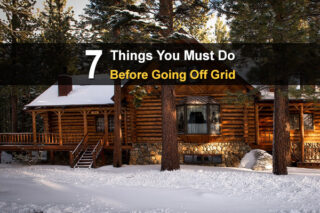Estimated reading time: 7 minutes
What do you do when you finally find a property that checks all the right boxes–water well, mature trees, fertile soil, enough acres–but doesn’t have a liveable structure on it? Most would-be homesteaders want something they can live in temporarily while they work on building a house.
Many homesteaders settle for a manufactured home because the price is right and it can be up and running quickly. But what about a yurt? If you’re asking what a yurt is, don’t worry, you’re not alone. Read on for the low down on why you should consider a yurt for your homestead.
Want to save this post for later? Click Here to Pin It on Pinterest!
What is a Yurt?

A yurt is a round, tent-like structure traditionally used by the nomadic people of Mongolia. But that’s only the beginning. Yurts have been lived in by hippies and homesteaders in the Western Hemisphere for many decades, which means they’ve been adapted into more permanent-style dwellings than their more humble ancestors.
Traditional yurts are low, windowless structures insulated with wool felt and animal hides. Modern yurts are tall, airy structures that offer many upgrades and options that can make them feel downright luxurious.

- HerryLawford on Visualhunt.com / CC BY
The central feature of all yurts is a ring that anchors “ribs” radiating out from the center. These ribs are connected by a cable at the “hips” that gives the entire structure incredible rigidity. The simplicity of this structure is also what makes it such an attractive living option: it can be erected in one day.
What Makes Yurts so Great?
Without sounding too much like a yurt salesman, I’ll say that a yurt is a fantastic choice for someone who needs something to live in immediately. Because the only other option as quick and economical is a manufactured home or an RV, these are the comparisons we’ll be looking at.
Cost
There are a few yurt manufacturers in the US that offer a range of options. Being round, yurts are measured by their diameter. Bearing that in mind, yurts come in a range of sizes from 12 feet to 40 feet diameter.
Prices range from as low as $6,000 for a no-frills 12-footer to upwards of $50,00 for an ultra-deluxe 41-foot wood yurt with thermal glass windows and a metal roof. The bottom line is that you can have a complete structure for far less than you would spend on a manufactured home.
Ease of Construction
This is where the yurt really shines. A half dozen people can erect a traditional (canvas-walled) yurt in a weekend with minimal tools. It’s really easy to get your friends on board with a project like this because it’s exciting and novel.
You won’t need much more than a ladder, a screw gun, and maybe a little scaffolding to get the roof on some of the larger models. What’s even better—once you’ve completed this modern-day barn-raising, your friends will want to keep coming back to help on the homestead and see the progress you’ve made.
Look and Feel
While the interior of an RV or manufactured home can feel a little cramped and predictable, a yurt is a dream to walk into. The construction is unique and it is impossible from the outside to imagine how lofty, bright, and expansive the space feels inside. Even though the most basic yurt is essentially a fancy tent, they feel livable.

- footloosiety on Visual Hunt / CC BY
Versatility
From day one, the yurt offers absolute customization, starting from the ground-up. Truly, yurts can be built close to the ground on low platforms or can be stacked atop high structures with shaded porches, additional living space, or storage beneath.
The flooring is up to you, and once the structure is built, it is possible to partition off spaces indoors to create private rooms, lofts, a bathroom, kitchen, and more. This type of flexibility is one of the things that makes yurts so interesting to work with–it’s a bit of a choose-your-own-adventure structure!
Relative Long Term Value
Manufactured homes, like cars, begin depreciating the moment you buy them. Homes tend to do the opposite. A yurt is a sort of in-between thing. Unlike the alternatives, a yurt begins life at a pretty basic level and can always be upgraded. If you take the time to install wooden walls and a permanent roof, you can vastly increase the value of a yurt over time.

- StJenna on VisualHunt / CC BY-NC
What I find more interesting is the intrinsic value a yurt offers once it is no longer your primary living space. If your property is very beautiful or is close to a city that is a travel destination, then you may one day want to use your yurt as a short-term rental. There is something very cozy about a yurt that appeals to novelty-seeking travelers.
So, What’s the Downside?
There’s always a downside, isn’t there? Yurt living is no different. Here are the not-so-rosy realities about yurts.
Weather
Yurts perform really well in the winter, but only if you have insulation and a good heating source, like a wood stove or gas heater. The summer is another story. Unless you build under a good shade tree, it can get very hot in warm climates with windows oriented to the south or west.
When it rains it can be deafening, and if you’re in a canvas-walled model with canvas windows, getting those windows closed quickly can be a huge challenge. I personally would not want to experience a tornado in a yurt.
Sound
Much like a tent, there is nothing really keeping sound from coming in. This is a big deal if you live close to neighbors with barking dogs, loud music, and guns. On the other hand, if you’re isolated and in a peaceful place, the sound of crickets can be soothing.
Pests
Some people never have a single problem, but others fight off ants, cockroaches, and rodents. These pest invasions are wholly a result of location, construction type, and cleanliness.
Conclusion
While yurt life isn’t for everyone, it is certainly not without its charms. If you want a living structure that is unusual, flexible, and affordable, then a yurt may be just the thing.
However, if you want something with rooms, fixtures, and a conventional quality, then you shouldn’t consider it. Any homesteader who wants a living space and an adventure rolled into one will do well with a yurt.
Like this post? Don't Forget to Pin It on Pinterest!











